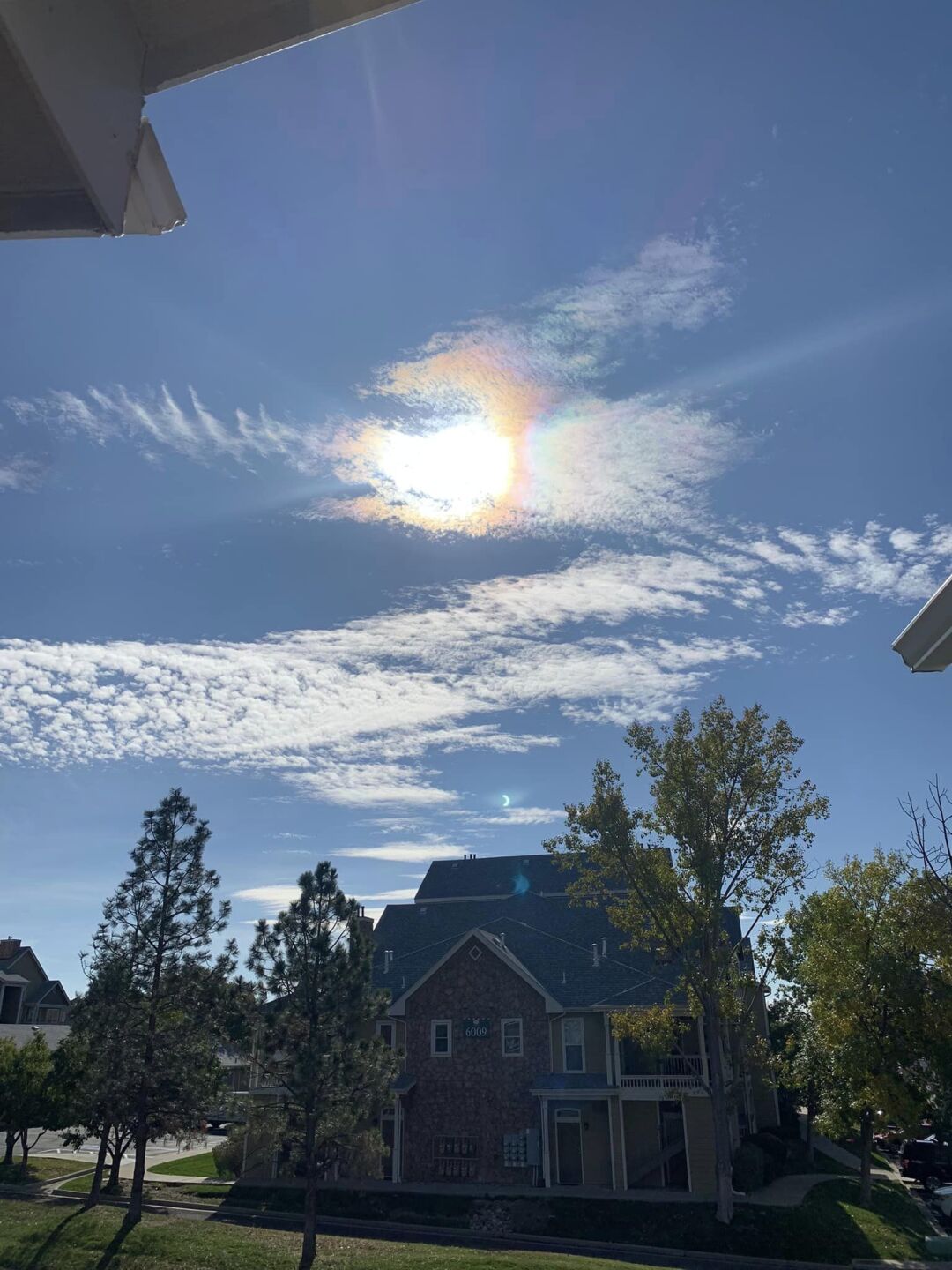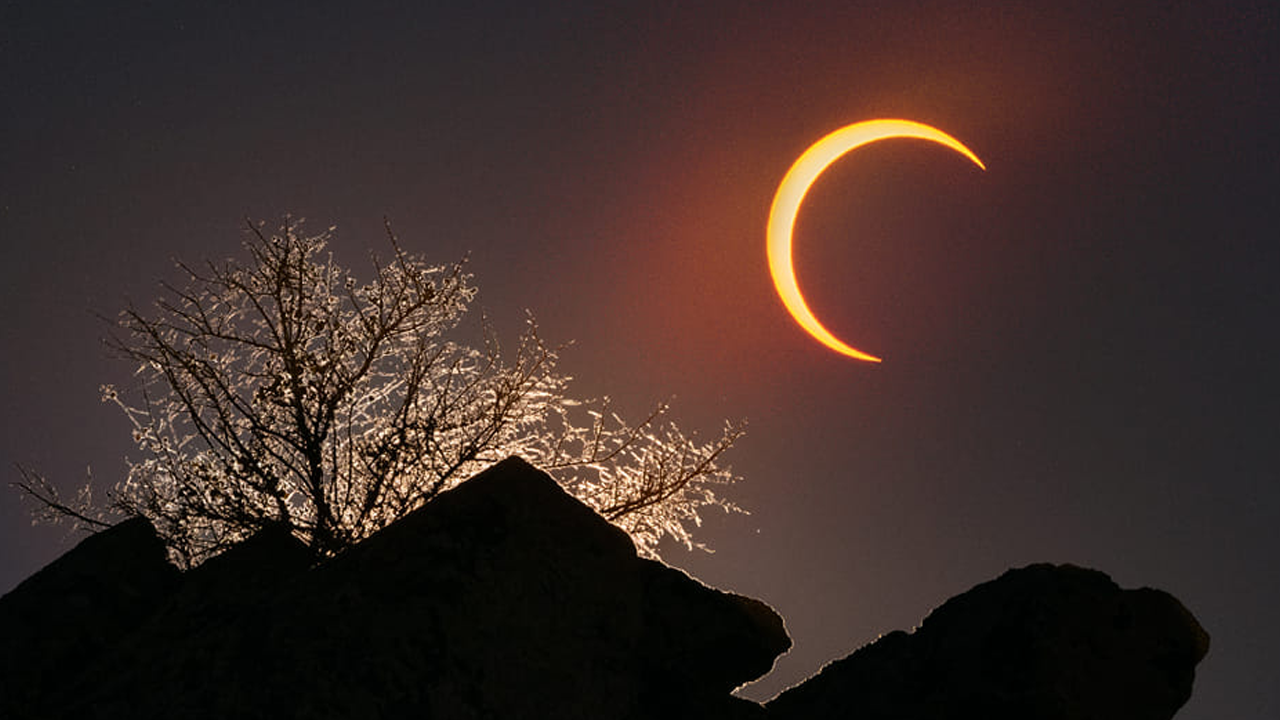DENVER — A rare “ring of fire” eclipse of the sun began making its way across Colorado Saturday. It was a spectacular show for some parts of the state as the moon moved into place and the ring formed.
Hundreds of people showed up to the Denver Museum of Nature and Science for a viewing party.
"I think it's amazing,” said Sandra Holloway. "Whenever you see the stars or the moon or the sun, we're just so oblivious to actually what's going on around us. That's just kind of how I felt."
The eclipse caused the sky to grow noticeably dimmer for a few minutes as the moon crossed in front of the sun.
Colorado photographers posted some amazing photos of the phenomenon to our Discover Colorado | Through Your Photos Facebook page, and some of them can be viewed in the slideshow below.
Although many of us in Colorado were treated to a rare sight, the best views were had in the direct path of the eclipse, like in Albuquerque.
There were hoots, hollers and yelps for those with an unfettered view in the New Mexico city, where the celestial event coincided with an international balloon fiesta that typically draws tens of thousands of spectators and hundreds of hot air balloon pilots from around the world.
They got a double treat, with balloons lifting off during a mass ascension shortly after dawn and then the eclipse a couple hours later. Organizers had 80,000 pairs of view glasses on hand for the massive crowd and some pilots used their propane burners to shoot flames upward in unison as the spectacle unfolded.

Allan Hahn of Aurora, Colorado, has attended the festival for 34 years, first as a crew member and then as a licensed balloon pilot. His balloon, Heaven Bound Too, was one of 72 selected for a special “glow” performance as skies darkened.
“It’s very exciting to be here and have the convergence of our love of flying with something very natural like an eclipse,” he said.
Unlike a total solar eclipse, the moon doesn’t completely cover the sun during a ring of fire eclipse. When the moon lines up between Earth and the sun, it leaves a bright, blazing border.
Saturday’s path: Oregon, Nevada, Utah, New Mexico and Texas in the U.S., with a sliver of California, Arizona and Colorado. Next: Mexico’s Yucatan Peninsula, Belize, Honduras, Nicaragua, Costa Rica, Panama, Colombia and Brazil. Much of the rest of the Western Hemisphere gets a partial eclipse.

Viewing all depends on clear skies — part of the U.S. path could see clouds. NASA and other groups livestreamed it.
The event brought eclipse watchers from around the U.S. to remote corners of the country to try to get the best view possible. At Bryce Canyon National Park in southern Utah tiny lights could be seen along a well known trail that snakes through a valley of red rock hoodoos as eclipse enthusiasts hit the trail before sunrise to stake out their preferred spots in nooks and crannies along the way.
With the ring of fire in full form, cheers echoed through the canyons of the park as if the home team just hit a home run.
Watch a replay of the eclipse in the player below:
“I just think it’s one of those things that unites us all,” said John Edwards, a cancer drug developer who traveled alone across the country to try to watch the eclipse from Bryce Canyon. “I just think it’s seeing these unique experiences that come rarely is what got me here. This is about as rare as it gets.”
Kirby James and Caroline McGuire from Toronto didn’t realize they would be in a prime spot to watch the eclipse when they planned their trip to southern Utah. Their luck led to what McGuire called an “epic, epic” at the national park.
“Nothing that you can read could prepare you for how it feels,” said Kirby James, 63, a co-founder of a software company. “It’s the moment, especially when the ring of fire came on, you realized you were having a lifetime experience.”
For the small towns and cities along the path, there was a mix of excitement, worries about the weather and concerns they’d be overwhelmed by visitors flocking to see the annular solar eclipse.

As totality began in Eugene, Oregon, oohs and ahs combined with groans of disappointment as the eclipse was intermittently visible, the sun’s light poking through the cloud cover from behind the moon only at times.
Koren Marsh and her parents drove five hours from Seattle to be within the path of the eclipse. Making the trip to see the ring of fire was part of the celebrations for her 16th birthday. Despite the poor viewing weather, she said it was still cool to witness totality as it peeked between the clouds.
“I’m underwhelmed but I wouldn’t say I’m disappointed,” she said. “It was worth it to me because I like science.”
Viewers on the East Coast were prepared to see less of the event — close to a quarter eclipse around midday in some areas, such as New York City — but were nonetheless geared up to watch the skies. In Maine, viewers expected to see only about 12% of the sun covered, but the Clark Telescope on the grounds of the Versant Power Astronomy Center at the University of Maine was open to the public.
“As the moon passes between the Earth and the sun, it casts its shadow on our planet. In a very real sense, solar eclipses are ‘made in the shade’ of the moon,” said Shawn Laatsch, director of the Versant Power Astronomy and the Maynard Jordan Planetarium.
Colombia’s Tatacoa desert was playing host to astronomers helping a group of visually impaired people experience the eclipse through raised maps and temperature changes as the moon blots out the sun.

At the Cancun Planetarium, young visitors built box projectors to indirectly and safely view the ring of fire. The ancient Maya — who called eclipses “broken sun” — may have used dark volcanic glass to protect their eyes, said archeologist Arturo Montero of Tepeyac University in Mexico City.
Brazil's Pedra da Boca state park, known for its rocky outcrops for climbing and rappelling was expecting crowds.
The entire eclipse — from the moment the moon starts to obscure the sun until it’s back to normal — is 2 1/2 to three hours at any given spot. The ring of fire portion lasts from three to five minutes, depending on location.
Next April, a total solar eclipse will crisscross the U.S. in the opposite direction. That one will begin in Mexico and go from Texas to New England before ending in eastern Canada.
The next ring of fire eclipse is in October next year at the southernmost tip of South America. Antarctica gets one in 2026. It will be 2039 before another ring of fire is visible in the U.S., and Alaska will be the only state in its direct path.
____
Rush reported from Eugene, Oregon. AP reporters Patrick Whittle in Portland, Maine; Susan Montoya Bryan in Albuquerque, New Mexico; Brady McCombs in Garfield County, Utah; Astrid Suarez in Bogota, Colombia; María Verza in Cancun, Mexico; and Mauricio Savarese in Sao Paulo, Brazil, contributed to this report.




